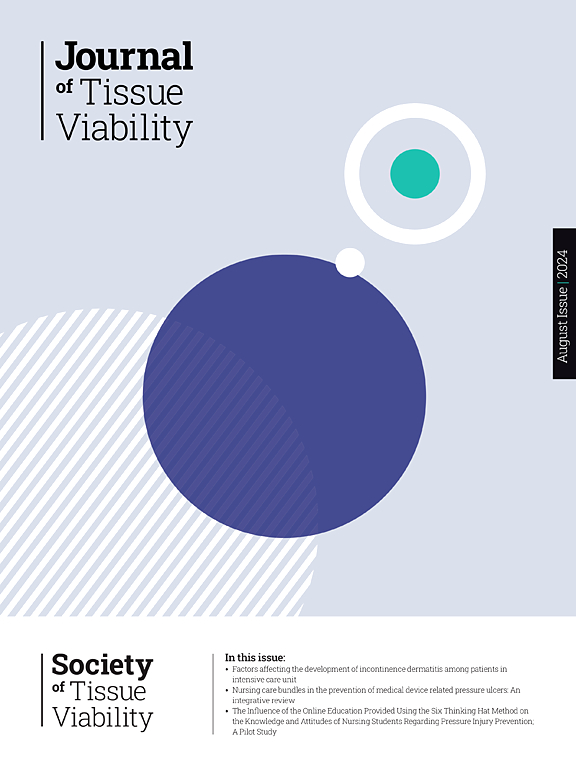Spinal cord stimulation in patients with diabetic foot: Determining prognosis using infrared thermography
IF 2.4
3区 医学
Q2 DERMATOLOGY
引用次数: 0
Abstract
Objective
We aimed to determine whether perioperative infrared thermography (IRT) could be used as an index of success in the treatment of spinal cord stimulation (SCS) in patients with diabetic foot (DF) and in selecting suitable candidates for long-term SCS.
Methods
Thirty-three DF patients who met the inclusion criteria underwent permanent SCS implantation at Shengjing Hospital from January 2021 to August 2023. Patients were grouped by preoperative Wagner grading, and peripheral sensory neuropathy was tested with a 10-g monofilament. Preoperative and 1-week postoperative IRT was performed to record lower limb skin temperature. Patients were divided into success (no amputation) and failure (amputation) groups based on limb salvage status. Receiver operating characteristic curve and logistic regression analysis were used for evaluation.
Results
All patients completed 6-month follow-up with pain relief (preoperative VAS: 6.82 ± 1.32; postoperative VAS: 5.48 ± 1.18; P < 0.001), and 52 limbs were salvaged (success rate: 78.8 %). No significant difference in success rate was found among different Wagner grades (P = 0.293). The success group had increased postoperative IRT (△IRT: 0.65 °C), while the failure group had decreased IRT (△IRT: 0.70 °C). The success rate was lower in patients with large-fiber neuropathy (59.1 % vs 88.6 %, P = 0.007). The diagnostic threshold of △IRT was −0.12 °C (AUC = 0.79, P < 0.001). Logistic regression showed large-fiber neuropathy (P = 0.025) and △IRT (P = 0.001) were related to prognosis.
Conclusion
SCS treatment effectively relieved lower limb pain. Patients with DF and large-fiber neuropathy had a lower surgical success rate. IRT was significantly higher in the treatment success group. Perioperative IRT changes of < –0.12 °C and combined large-fiber neuropathy were identified as warning signs, and patients with these signs should be treated with caution when receiving long-term SCS therapy. IRT can be used as a diagnostic index for the prognosis of patients with DF receiving SCS and to select suitable long-term SCS treatment candidates.
脊髓刺激治疗糖尿病足患者:用红外热成像确定预后
目的探讨围手术期红外热成像(IRT)是否可以作为糖尿病足(DF)患者脊髓刺激(SCS)治疗成功的指标,并选择合适的长期SCS患者。方法于2021年1月至2023年8月在盛京医院接受33例符合纳入标准的DF患者永久性SCS植入。患者按术前Wagner分级进行分组,周围感觉神经病变用10g单丝检测。术前和术后1周进行IRT记录下肢皮肤温度。根据残肢状况将患者分为成功组(未截肢)和失败组(截肢)。采用受试者工作特征曲线和logistic回归分析进行评价。结果所有患者均完成6个月的随访,疼痛缓解(术前VAS: 6.82±1.32;术后VAS: 5.48±1.18;P < 0.001),保留肢体52条(成功率78.8%)。不同Wagner分级间成功率无显著差异(P = 0.293)。成功组术后IRT增加(△IRT: 0.65°C),失败组术后IRT减少(△IRT: 0.70°C)。大纤维神经病变患者的成功率较低(59.1% vs 88.6%, P = 0.007)。△IRT的诊断阈值为- 0.12°C (AUC = 0.79, P < 0.001)。Logistic回归分析显示,大纤维神经病变(P = 0.025)和△IRT (P = 0.001)与预后相关。结论scs治疗可有效缓解下肢疼痛。DF合并大纤维神经病的患者手术成功率较低。治疗成功组IRT显著增高。围手术期IRT变化<; -0.12°C及合并大纤维神经病变为警示信号,有这些信号的患者在接受长期SCS治疗时应谨慎对待。IRT可作为DF患者接受SCS预后的诊断指标,选择合适的长期SCS治疗方案。
本文章由计算机程序翻译,如有差异,请以英文原文为准。
求助全文
约1分钟内获得全文
求助全文
来源期刊

Journal of tissue viability
DERMATOLOGY-NURSING
CiteScore
3.80
自引率
16.00%
发文量
110
审稿时长
>12 weeks
期刊介绍:
The Journal of Tissue Viability is the official publication of the Tissue Viability Society and is a quarterly journal concerned with all aspects of the occurrence and treatment of wounds, ulcers and pressure sores including patient care, pain, nutrition, wound healing, research, prevention, mobility, social problems and management.
The Journal particularly encourages papers covering skin and skin wounds but will consider articles that discuss injury in any tissue. Articles that stress the multi-professional nature of tissue viability are especially welcome. We seek to encourage new authors as well as well-established contributors to the field - one aim of the journal is to enable all participants in tissue viability to share information with colleagues.
 求助内容:
求助内容: 应助结果提醒方式:
应助结果提醒方式:


